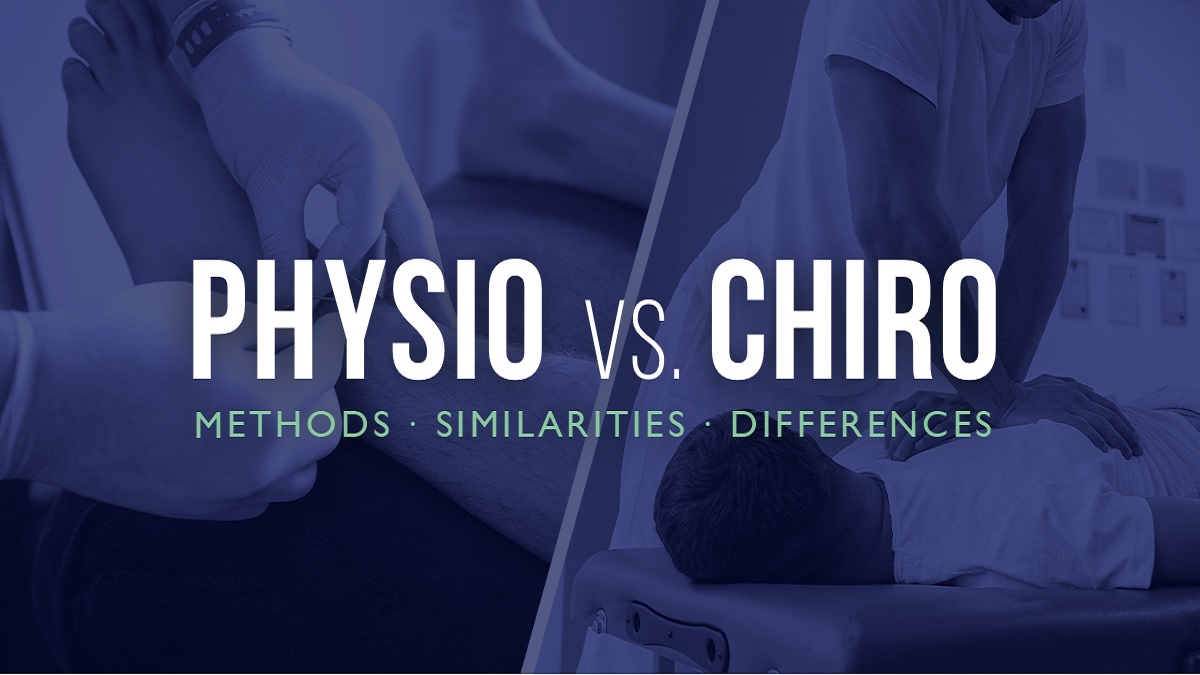From prehistoric times, when the treatment of disease was based on the holistic approach, to present-day life treatment choices that are highly specific to the nature of the disease, the medical profession has evolved significantly. From the time, Imhotep emerged as the first doctor in ancient Egypt, till the mid-1980s, when a need for a multidisciplinary team was felt; multiple specialties branched off into a diverse healthcare profession. Physiotherapists and chiropractors are two such healthcare professionals who practice in many common ways yet they are completely different. This blog aims at highlighting a few of their distinguishing features.
Who is a Physiotherapist?
Physiotherapists are health care professionals with a five-year doctorate in physical therapy (DPT). They focus on pain management and help people recover from injury, illness, and disability through movement, exercise, manual therapy, and other physical means such as electrotherapy, cryotherapy, hydrotherapy, etc. Physiotherapy protocols are based on the concept of restoring the natural biomechanics of the body keeping, the kinetic and kinematic components of the forces, in view. The process involves a careful assessment, identifying the cause through a thorough examination, making an appropriate diagnosis, and designing an effective treatment plan.

Physiotherapists deals with patients who are suffering from musculoskeletal disorders, neuromuscular conditions, cardiovascular compromise due to various cardiac and lung pathologies, post-surgery immobilization, post-partum musculoskeletal disorders, and degenerative joint diseases. Treatment is carried out by employing different modalities and manual therapy techniques.
Read More: Yoga vs Pilates: how to know which one is right for you? – About Pakistan
Types of Physiotherapists:
After completion of degree program in physiotherapy, physiotherapists have wide range of specialized field of practice to choose from. Based on particular skills physiotherapists can be classified as:
- Neuromuscular physiotherapists:
A Physiotherapist can become a neuromuscular or neurological physiotherapist by pursuing a masters degree in neuromuscular physical therapy. They have the skills to treat patients with neuromuscular disorders such as after a cerebrovascular accident (CVA) commonly termed as stroke, spinal cord injuries, multiple sclerosis, Parkinson’s disease, peripheral nerve injuries and traumatic brain injuries. They customize the treatment protocol according to patients condition. Usually, restoration to normal body functioning takes a long period of time, so patient’s compliance is important to help him gain independence in ADLs and IADLs.
- Pain physiotherapists:
Pain physiotherapists or musculoskeletal physiotherapists are those who manage chronic pain through manual therapy techniques, muscle energy techniques and mobilization techniques. They earn a masters degree in musculoskeletal physiotherapy to become pain management specialist physiotherapists. They have to deal with patients who are suffering from musculoskeletal disorders which are not secondary to some other systemic cause. They have smart goals to help the patient to lead a pain free and an active life. Treatment is often initiated by recruiting the weak muscles of the body and strengthening them by regular strengthening exercises. Their ultimate goal is to increase the range of motion at the joints and restore the mobility.
- Sports physiotherapists:
Sports activities causes the muscles to work beyond their capacity, which makes them vulnerable to injuries. A sports physiotherapist treats the patients with sports injuries such as sprains ,strains, tendon or ligament rupture, muscular spasm, delayed onset muscle soreness. Sports physiotherapist is the one who has to work on the generalized fitness of the athletes by guiding them about safe playing techniques and assessing their musculoskeletal strength and endurance. It is important for the sport Physiotherapist to be aware of the mechanism of injury so that the measures to work on the healing of the athletes can be taken accordingly.
- Cardiopulmonary Physiotherapist:
Cardiopulmonary physiotherapists primarily work to improve the breathing and aerobic capacity in patients with asthma, emphysema, interstitial lung disease, chronic obstructive pulmonary disease (COPD), pulmonary fibrosis, heart failure and other cardiac conditions. They enhance the patient’s ability to properly complete the breathing cycle through chest Physiotherapy. There are certain techniques that include segmental breathing, diaphragmatic breathing, active cycle of breathing techniques. A chest Physiotherapist also helps the patient in removing the secretions from respiratory track through percussions and vibrations that are given both manually and mechanical. Chest Physiotherapist is an integral part of the multidisciplinary team.
- Women health Physiotherapists:
This specialty in physiotherapy is comparatively novel and one of the most demanded field. Women health Physiotherapists focus on the education of the females about multiple health disorders and ways to prevent many age related diseases such as osteoarthritis, osteoporosis and low back pain. A women health physiotherapists deal with the partum and postpartum complications as well as helping the patient to experience a smooth pregnancy. Following a child birth, females become prone to many musculoskeletal disorders here is when a women health physiotherapists design a post-partum rehabilitation plan for the patients.
Read More: Why Need Of Physiotherapy Is Increasing In Pakistan – About Pakistan
Who is a Chiropractor?
Chiropractors are health care professionals who earn a doctor of chiropractic degree followed by a year of clinical training and securing a license. They focus on treating musculoskeletal problems primarily through spinal adjustment where they apply force on spinal joints with hands and move a hypermobile joint in a specific direction for better alignment. Chiropractic care began as a profession in 1895 when Daniel David Palmer adjusted the spine of a deaf janitor and claimed to restore his hearing. Chiropractors treat multiple health-related problems including lower back pain, neck pain, headache, work, and sports-related injuries, and restricted movement in the back, shoulders, neck, and limbs.

Chiropractors examine a patient’s spine by looking for any misalignment. They also perform tests and may take x-rays or MRIs to diagnose the patient’s condition, then come up with a plan and regularly evaluate the condition of the patient after each session.
Types of Chiropractors
Based on various techniques of manipulation chiropractors are grouped into different types. All the techniques are practiced to manage pain, but through different approaches. Some of the types of techniques practiced by chiropractors are as under:
The diversified technique:
Chiropractors who adopt this technique has three main goals
- To restore spinal alignment
- Repair joint dysfunction
- Ensure proper movement and mobility
Through this technique patient’s range is immediately improved which was limited due to misalignment of bones and joints. 96% of chiropractors follow this technique.
Spinal manipulation:
This technique is somewhat similar to manual therapy mobilization and is practiced both by the chiropractors and the physiotherapists. This technique primarily helps in relieving pressure on joints, reduce inflammation and improves nerve function. It utilizes a gentle thrust on spine and a greater degree of stretch.
Thompson drop-table technique:
In this technique chiropractors use a specially designed table constructed of padded platform fitted with drop mechanism so that patients can be “dropped” as a quick thrust is applied. The dropping motion is comforting and resembles gentle vibrations. Drop table is used as a tool to generate relief across the spine and joints.
Gonstead Adjustment:
Many chiropractors use this technique for the spinal manipulation due to its unique aspect of specificity of the contact point on the chiropractor’s hand. Adjustment can be performed while the patient is sitting or side lying. It enables the chiropractors to localize the point of discomfort in the spine so the thrust is given in that specific direction.
Read More: Why Physiotherapy is Important for Health – About Pakistan
The activator method:
A small handheld device is used to adjust the tone of the nervous system through gentle impulses in the extremities or vertebral segments of spine. This method is effective in treatment of headache as well as low back pain.
Flexion distraction method:
A special table is used that alternatively distracts and flexes the spine in a gentle rhythmic pattern. This is the method of choice while treating the patients with disc injuries or those who have acute pain in back and legs and other techniques can potentially cause a damage to the spine.
Spinal decompression:
This method is of great significance to treat the patients with herniated discs or recurrent disc bulge. A traction table is used which carefully stretches the spine facilitating the flow of water, oxygen and other fluids in the spine.
How do Physiotherapists and Chiropractors differ?
Physiotherapy:
1- Focuses on a holistic mode of treatment and works on whole-body biomechanics along with restoring normal range of motion and joint functioning.
2- Treatment plan includes stretching, mobility exercises, muscle strengthening, and performing some manipulations for certain conditions to address decreased mobility at a particular joint.
3- Incorporates the use of electrotherapy, cryotherapy and hydrotherapy along with manual therapy and exercise regime.
4- Physical Therapy treatment helps the patient recover gradually but the results are often long-lasting thus it is a slow but progressive process. As the treatment plan is based on exercises which recruit the weak muscles and strengthen them when done for a longer period of time.
5- Have a role in managing patients in ICU, post-surgical rehabilitation, post-stroke rehabilitation, and post-partum rehabilitation.
Chiropractic care:
1- Focuses mostly on issues related to the spine or problems in extremities that are originated from the spine, such as neck pain, back pain, pain, or numbness in upper and lower limbs.
2- The treatment plan is based on spinal manipulation and adjustment to help the body to heal itself.
3- Focuses mainly on manual therapy without the fusion of other types of therapies.
3- Chiropractic care gives immediate relief, but it requires a patient to take the sessions at regular intervals for maintenance purposes.
4- Limited role in dealing with post-partum patients who develop back pain following childbirth.
How do physiotherapist and chiropractors resemble?
Both physiotherapists and chiropractors are healthcare professionals with years of education, clinical training, and expertise. They serve in either tertiary care hospitals or own private clinical setups. They most often manage similar conditions; sometimes a patient may need a treatment regime that incorporates the treatment plan of both professionals. Physical therapists and chiropractors similarly assess the patient; take a history, examine physically, perform physical diagnostic tests or sometimes order other confirmatory tests.
Read More: Natural Remedies For Reducing Anxiety and Stress – About Pakistan
They anchor their treatment on hands-on manipulation or manual therapy. Both emphasize non-invasive and non-surgical approaches to managing pain and discomfort. They share identical treatment goals for the patient, for which both not only concern the outcomes of a single session, but also emphasize the long-term outcomes of the treatment.
Whom should you visit?
The answer to this question depends on the type of condition you have and your specific needs. A careful examination determines which type of therapy is right for you. Sometimes combining a physical therapy treatment with chiropractic care may alleviate the symptoms and enhance the quality of life. If the root cause lies within the spine good physiotherapy along with chiropractic care can do wonders.


















